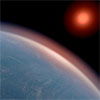| Mar 26, 2022 |
|
|
|
(Nanowerk News) The planetary atmosphere outside the solar system can be revealed by measuring bandpass-dependent transit depths, according to a study by Prof. LIU Jifeng and his PhD student YANG Fan from the National Astronomical Observatories of the Chinese Academy of Sciences (NAOC).
|
|
By comparing the high-precision transit light curves from the Transit Exoplanet Survey Satellite (TESS) and other telescopes, they found evidence of haze dominant atmosphere of exoplanet KELT-19Ab.
|
|
This work was published in The Astronomical Journal (“Revisiting KELT-19Ab, WASP-156b, and WASP-121b in the TESS Era”).
|
 |
| The transmission spectra resolve the planet atmosphere. (Image: Natasha E. Batalha, NASA Ames Research Center)
|
|
When a planet comes across its host star, the transit depth would leave imprints of its features, leading to the detection of more than 3,000 exoplanets. This transit depth would be different due to the transmission variety of certain compositions. The atmospheric features are thereby resolvable through analyzing the so-called transmission spectra.
|
|
The space telescope TESS offers high-quality time-domain images for nearby exoplanets. NAOC-Caltech research team focused on obtaining precise light curves from the raw TESS data. They developed an independent data reduction pipeline, particularly effective in deblending the nearby contaminated flux.
|
|
The researchers also checked other factors possibly causing transit depths difference, e.g., sampling rate, baseline modeling, fitting prior modification, stellar variability.
|
|
“The transit depths in different bands reveal the existence of the KELT-19Ab atmosphere,” said YANG Fan from NAOC, first author of the study. “We expect more opportunities to gain insight into the planet atmosphere, with new powerful telescopes e.g., JWST, LSST and Sitian.”
|
|
The study on exoplanet atmosphere has been rapidly speeding up due to the joint analysis of ground-based telescopes and space telescopes like Hubble and TESS in the recent decade. Sitian telescope array proposed by Chinese astronomers aims at producing high-precision photometry monitoring the sky.
|
|
“Sitian will detect and analyze up to 25,000 planets in ten years. This fivefold planet sample size and the interesting targets involved will significantly improve our knowledge of the planet and its atmosphere,” said YANG Fan.
|


